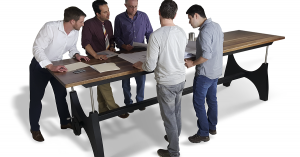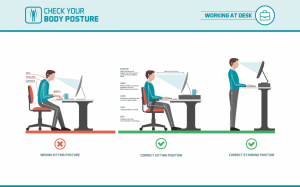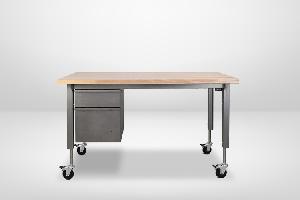
5 Benefits of Ergonomics in the Workplace
Read the 5 ways you can benefit from ergonomics in the workplace to improve the performance and well-being of your employees in the office!
Have you ever really looked at people? Really studied them in detail?
The industrial designer Henry Dreyfuss did, starting back in the nineteen thirties.
Dreyfuss and his firm, Henry Dreyfuss and Associates, applied new techniques in the study of human factors and ergonomics in the workplace by systematically measuring and quantifying variations in height, weight, girth, range of motion, range of vision, and so forth among the contemporary population of modern consumers. (This type of study, known as anthropometry, was originally developed by anthropologists to study ancient civilizations.)
In 1955, Dreyfuss published Designing for People, which outlined the principles of ergonomics that guided their firm during the development of many iconic product designs. These include the early Hoover upright vacuum cleaner, and the ubiquitous round Honeywell thermostat — as well as later products, such as Princess and Trimline telephones and the origami-inspired folding Polaroid SX70 camera.
Dreyfuss Publishes His Seminal Work in Ergonomic Solutions: The Measure of Man
In 1959, Dreyfuss followed up Designing for People with the seminal work, The Measure of Man.
As part of their research, Dreyfuss Associates divided the male (nicknamed “Joe”) and female (nicknamed “Josephine”) American consumer population into size percentiles, ranging from 1 to 100. They then created human outlines, or “templates,” to represent each of the percentiles, from the smallest woman to the largest man. With this information in hand, industrial designers could evaluate product designs on the drafting table using real-world data directly from Dreyfuss’ human templates.
How do these human templates work in practice?
Take something we’re all familiar with — car design for example.
The role of ergonomics can be easily understood in the context of designing new car interiors, which have to accommodate both the smallest female and largest male drivers.
Using Dreyfuss’ graduated human templates, designers developing a car interior would be able to quickly identify what adjustments would be needed for a small woman from the 2nd percentile to see the road ahead. The same goes for the larger man. Designers can easily overlay a Dreyfuss template representing a 99th percentile man on top of a proposed design to visualize, for example, how difficult it would be for him to fit behind the steering wheel or to avoid hitting his head on the roof of a low-profile sports car.
The Measure of Man is still considered the ergonomics “bible” for industrial designers and human factors engineers today. It’s been updated over the years to incorporate new scenarios in office ergonomics, such as office workers using computer monitors and keyboards at their desks — as well as to account for the increasing height (and, unfortunately, weight) in today’s population.
How Do Your Office Ergonomics Measure Up?
It’s been almost 60 years since the original edition of The Measure of Man was published — and, no doubt, there have been quite a few changes in office ergonomics during these intervening years.
In comparison to earlier generations, today’s office workers tend to be responsible for producing their own research (thanks to computer software and the internet) as well as typing up and printing their own documents (rather than relying on dictation or a typing pool.)
As a result, today’s workers often find themselves spending hours and hours staring at a computer screen, typing on a keyboard and manipulating a computer mouse.
If we don’t pay attention to proper office ergonomics, these repetitive work habits can have a negative impact on our physical health. But, rather than focusing on the negative (and sounding like we’re ‘nagging’), let’s point out the top five benefits of implementing proper ergonomics in the workplace:
1. Ergonomics Helps Ensure Physical Safety in the Workplace
Most accidents occur suddenly and unexpectedly, but proper ergonomics in the office can help prevent many types of accidents.
As we’ve written about before, tripping and falling are among the leading causes of workplace accidents. To prevent them, your Formaspace Design Consultant can help you design and specify custom storage solutions for your office – so that everything has a place and everything is in its place – which can significantly reduce the chance of tripping and falling accidents.
It’s also critical to keep all power cords as well as computer and networking cables up and away from the floor, which is why we offer built-in power-systems across our office furniture lines. Little details like these can make a big difference in worker comfort and safety. Even the choice of leg design on tables and desks can reduce trip hazards. Talk with a Formaspace Design Consultant who can help review all your options for creating a safer, more ergonomically fit work environments.
In addition to avoiding trip hazards, ergonomic analysis can also help you set safe weight and size limits for employees picking up and carrying heavy objects by hand – a common hazard in your office’s shipping and receiving department.
For example, when it comes to lifting heavy or awkward items, Formaspace can provide custom, hydraulic-powered lifts that are built-in alongside packing stations or other work surfaces where employees handle heavy items. Using lifts and other safety devices we recommend will help prevent on-the-job accidents and injuries.
2. Proper Ergonomic in the Workplace Can Prevent Musculoskeletal Disorders (MSDs)
In addition to helping prevent injuries due to sudden exertion (due to tripping/falling or lifting heavy objects), proper office ergonomics can help prevent other types of common Musculoskeletal Disorders (MSDs) that can develop in the office, such as Tendonitis and Carpal Tunnel Syndrome.
These types of injuries can occur when workers repeat the same motions over and over again, particularly when maintaining an improper or awkward posture.
So how do we prevent MSD-type injuries?
Read more ... https://formaspaceoffice.com/articles/business-owner/5-benefits-ergonomics-workplace/?utm_source=einpresswire&utm_medium=content&utm_campaign=article-072517
Brooke Turner
Formaspace
8002511505
email us here
EIN Presswire does not exercise editorial control over third-party content provided, uploaded, published, or distributed by users of EIN Presswire. We are a distributor, not a publisher, of 3rd party content. Such content may contain the views, opinions, statements, offers, and other material of the respective users, suppliers, participants, or authors.




